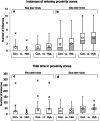Female Sexual Preferences Toward Conspecific and Hybrid Male Mating Calls in Two Species of Polygynous Deer, Cervus elaphu s and C. nippon
- PMID: 27217596
- PMCID: PMC4860407
- DOI: 10.1007/s11692-015-9357-0
Female Sexual Preferences Toward Conspecific and Hybrid Male Mating Calls in Two Species of Polygynous Deer, Cervus elaphu s and C. nippon
Abstract
The behavioral processes at the basis of hybridization and introgression are understudied in terrestrial mammals. We use a unique model to test the role of sexual signals as a reproductive barrier to introgression by investigating behavioral responses to male sexual calls in estrous females of two naturally allopatric but reproductively compatible deer species, red deer and sika deer. Previous studies demonstrated asymmetries in acoustic species discrimination between these species: most but not all female red deer prefer conspecific over sika deer male calls while female sika deer exhibit no preference differences. Here, we extend this examination of acoustic species discrimination to the role of male sexual calls in introgression between parent species and hybrids. Using two-speaker playback experiments, we compared the preference responses of estrous female red and sika deer to male sexual calls from conspecifics versus red × sika hybrids. These playbacks simulate early secondary contact between previously allopatric species after hybridization has occurred. Based on previous conspecific versus heterospecific playbacks, we predicted that most female red deer would prefer conspecific calls while female sika deer would show no difference in their preference behaviors toward conspecific and hybrid calls. However, results show that previous asymmetries did not persist as neither species exhibited more preferences for conspecific over hybrid calls. Thus, vocal behavior is not likely to deter introgression between these species during the early stages of sympatry. On a wider scale, weak discrimination against hybrid sexual signals could substantially contribute to this important evolutionary process in mammals and other taxa.
Keywords: Deer; Hybridization; Introgression; Mating; Sexual communication; Sexual preference; Species discrimination; Vocalization.
Figures



Similar articles
-
Roars, groans and moans: Anatomical correlates of vocal diversity in polygynous deer.J Anat. 2021 Dec;239(6):1336-1369. doi: 10.1111/joa.13519. Epub 2021 Aug 3. J Anat. 2021. PMID: 34342877 Free PMC article.
-
Variability of female responses to conspecific vs. heterospecific male mating calls in polygynous deer: an open door to hybridization?PLoS One. 2011;6(8):e23296. doi: 10.1371/journal.pone.0023296. Epub 2011 Aug 24. PLoS One. 2011. PMID: 21887242 Free PMC article.
-
Introgression of exotic Cervus (nippon and canadensis) into red deer (Cervus elaphus) populations in Scotland and the English Lake District.Ecol Evol. 2018 Jan 22;8(4):2122-2134. doi: 10.1002/ece3.3767. eCollection 2018 Feb. Ecol Evol. 2018. PMID: 29468030 Free PMC article.
-
Introgression through rare hybridization: A genetic study of a hybrid zone between red and sika deer (genus Cervus) in Argyll, Scotland.Genetics. 1999 May;152(1):355-71. doi: 10.1093/genetics/152.1.355. Genetics. 1999. PMID: 10224266 Free PMC article.
-
Investigating temporal changes in hybridization and introgression in a predominantly bimodal hybridizing population of invasive sika (Cervus nippon) and native red deer (C. elaphus) on the Kintyre Peninsula, Scotland.Mol Ecol. 2010 Mar;19(5):910-24. doi: 10.1111/j.1365-294X.2009.04497.x. Epub 2010 Jan 21. Mol Ecol. 2010. PMID: 20102517
Cited by
-
Rutting vocal display in male impala (Aepyceros melampus) and overlap with alarm context.Front Zool. 2021 Jan 7;18(1):2. doi: 10.1186/s12983-020-00383-9. Front Zool. 2021. PMID: 33413460 Free PMC article.
-
Roars, groans and moans: Anatomical correlates of vocal diversity in polygynous deer.J Anat. 2021 Dec;239(6):1336-1369. doi: 10.1111/joa.13519. Epub 2021 Aug 3. J Anat. 2021. PMID: 34342877 Free PMC article.
-
A Microsatellite Genotyping-Based Genetic Study of Interspecific Hybridization between the Red and Sika Deer in the Western Czech Republic.Animals (Basel). 2021 Jun 7;11(6):1701. doi: 10.3390/ani11061701. Animals (Basel). 2021. PMID: 34200330 Free PMC article.
References
-
- Andersson M. Sexual selection. Princeton: Princeton University Press; 1994.
LinkOut - more resources
Full Text Sources
Other Literature Sources
